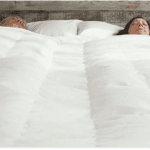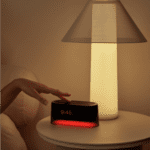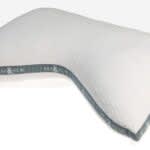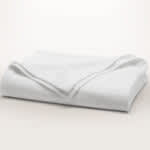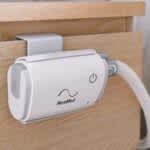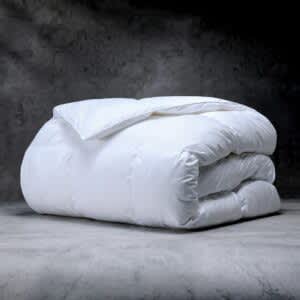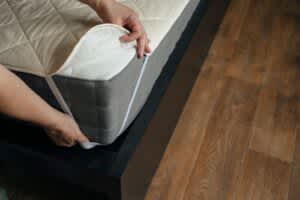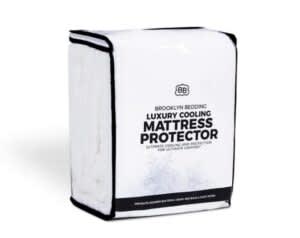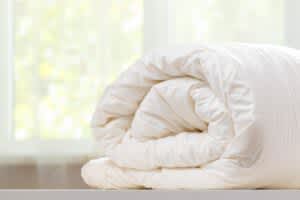Have you ever considered using a weighted blanket for sleep? Long used as a sleep aid and anxiety reducer for people with conditions including ASD, ADHD, and sensory processing disorders, weighted blankets have definitely caught the interest of the general public.
Anxiety is a major problem for sleep. There’s an abundant body of research that demonstrates the anxiety-sleep connection. I see anxiety wreaking havoc with my patients sleep and I hear from many how stress, anxiety, and a “wired and tired” mind interfere with your ability to fall asleep and rest soundly at night. Anxiety can intrude on sleep at any age; kids have this sleep issue, as do many adults. It can occur for all kinds of reasons, from environmental and circumstantial stressors to physical and psychological conditions.
Looking for the Best Weighted Blankets?
The Bearaby Velvet Napper tops our list of the best weighted blankets thanks to its silky-smooth feel, open-knit design, and multiple weight options. Check out our full list of the best weighted blankets to see more options.
What’s It Like To Sleep Under a Weighted Blanket?
Many people describe the feeling of a weighted blanket as like being held in a gentle hug. Weighted blankets apply light, even pressure over the entire body. That can help keep you more still when you’re in bed, and provides the soothing sensation of being gently held, which creates for many people a deep sense of relaxation and calm that makes it easier to fall asleep—and may help you sleep more soundly, with fewer restless awakenings during the night.
Weighted blankets have an interior lining that’s filled with evenly distributed weight. Different blankets come at different weights, ranging from 4 or 5 pounds to 25 or 30 pounds. In our research, we determined that 12 pounds of evenly distributed weight was ideal for sleep and relaxation—without excessive pressure or the generation of too much heat (which can interfere with sleep).
How Do Weighted Blankets Work?
Think about how comforting and relaxing it feels to be embraced in a good, long hug from someone you love. Think about how soothed a baby is when swaddled, or a child is when snuggled in a parent’s lap. Think about how relaxed—and often sleepy—you feel after you’ve had a massage. Touch and gently applied pressure have powerful psychological and physical effects. Eliciting those effects is what weighted blankets can do.
The evenly distributed weight added to a blanket exerts what’s known as “deep pressure stimulation.” That’s the gentle, firm pressure that can also come from massage, or other physical contact. Deep pressure stimulation lowers arousal. As research shows, deep pressure stimulation decreases the activity of the body’s sympathetic nervous system—that’s the system that promotes alertness and vigilance, and responds to stressful stimuli. It’s the “fight or flight” division of the nervous system. At the same time, deep pressure stimulation increases activity of the parasympathetic nervous system, which is sometimes called the “rest and digest” system. When it’s activated, it lowers heart rate and blood pressure, and increases relaxation and feelings of calm.
A 2015 study examined the effects of deep pressure stimulation from weighted blankets, and found a 33 percent reduction in stress, as measured by a test of physiological signs of arousal. Among the participants, 63 percent reported feeling a decrease in anxiety, and 78 percent said they found using a weighted blanket a preferable way to increase their level of calm.
The changes to nervous system activity that come from deep pressure stimulation are accompanied by a cascade of changes to hormones, which also contribute to lower anxiety and generate feelings of calm. These hormonal changes can also be beneficial for sleep.
May Stimulate Oxytocin
This hormone can stimulate feelings of attachment and closeness, and generate a deep sense of calm (think about the relaxing feeling of a warm, welcome hug—that’s oxytocin at work). A highly versatile hormone with functions we’re still working to understand, oxytocin plays a number of roles in the body, from stimulating sexual arousal to encouraging social bonding and parent-child attachment, to reinforcing emotional memories.
Oxytocin also plays a facilitating role in sleep. This hormone is one of several that’s involved in regulating our sleep-wake cycles. Oxytocin levels go up during sleep, typically peaking during longer periods of REM deep into a night of sleep. A 2017 study found that increasing oxytocin during sleep can increase sleep time and sleep quality, and may reduce the symptoms of obstructive sleep apnea.
Can Decrease Cortisol
Research shows deep pressure stimulation reduces levels of cortisol, an alerting hormone that plays a central role in the body’s stress response. The stimulating effects of cortisol make it difficult to fall asleep and stay asleep throughout the night. An evening drop in cortisol is part of the body’s natural progression toward sleep—but feelings of stress, anxiety, and being wound up can interfere with that natural nightly drop. The gentle pressure of a weighted blanket may help your body with its natural nightly suppression of this stimulating hormone.
Can Increase Serotonin
Research also shows that deep pressure stimulation increases the hormones serotonin a “feel good” hormone that helps keep you in a more relaxed state, day and night. Serotonin helps to stabilize mood and regulate energy levels and also contributes to regulating sleep-wake cycles. A lack of serotonin can lead to depression and anxiety, and to disrupted circadian rhythms. Keeping serotonin levels healthy is one way to encourage healthy, restful, sleep routines.
Serotonin is what’s known as a “precursor” to melatonin, a key hormone that promotes our nightly rest. The body produces melatonin from serotonin through a chemical process; when serotonin levels are deficient, healthy, sleep-promoting levels of melatonin are also at risk.
How To Use a Weighted Blanket
The short answer is, just like you would any other blanket! When selecting a weighted blanket, you want one that’s heavy enough to exert the pressure you need, but not so heavy that it excessively restricts your movement, feels uncomfortable, or causes you to overheat in bed. Those effects can all be counterproductive to sleep.
You may find yourself more inclined to sleep with less clothing with a weighted blanket—go for it! Go ahead and shed some layers, and let the blanket do the work of keeping you warm and swaddled.
It’s important to note a weighted blanket can help you fall asleep more quickly and sleep better over the course of the night, but it can’t do ALL the work of a good night’s rest. You still need to pay attention to the basics, which are key for healthy sleep:
- Sticking to a consistent sleep schedule, with regular bedtimes and wake times
- Avoiding too much light exposure at night
- Not eating too heavily at night and close to bedtime
- Consuming alcohol only moderately, and ideally not within a few hours of bed
- Getting regular exercise
- Managing stress and supporting mood with relaxation practices, including meditation













